AMD Radeon HD 7750 & Radeon HD 7770 GHz Edition Review: Evading The Price/Performance Curve
by Ryan Smith & Ganesh T S on February 15, 2012 12:01 AM EST- Posted in
- GPUs
- AMD
- HTPC
- GCN
- Radeon HD 7000
Power, Temperature, & Noise
As always, we wrap up our look at a new video card with a look at the physical performance attributes: power consumption, temperatures, and noise.
While it’s the second sub-series of the 7000 series, the 7700 series is actually first in a number of ways for AMD. It’s the first midrange series to feature PowerTune since its introduction in 2010, and it’s the first time the 28nm process has been used on such low power cards. As such the power, temperature, and noise characteristics of the 7700 series are virtually a blank slate waiting to be filled.
| Radeon HD 7700 Series Voltages | ||||
| Ref 7750 Load | Ref 7770 Load | XFX R7770 BESDD | ||
| 1.1v | 1.2v | 1.2v | ||
The idle voltage for all 3 of our 7700 series cards was 0.825v. Meanwhile the load voltage for our 7750 was 1.1v, while it was 1.2v for both the reference 7770 and the XFX BESDD.
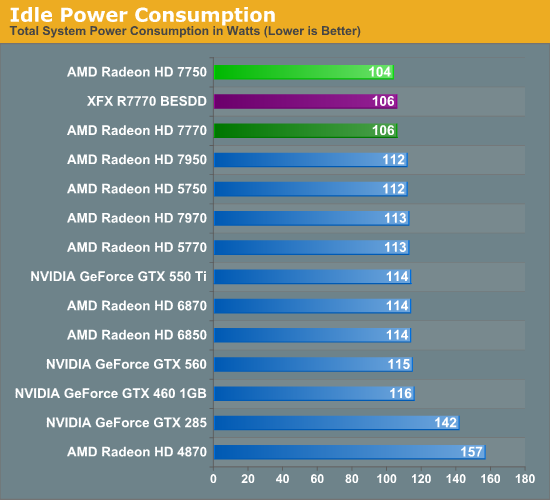
AMD’s official idle power consumption figure is <10W for both the 7750 and 7750. In practice we find that there’s a 2W difference between the two cards, with the 7750 coming in at 104W at the wall and the 7770 at 106W. AMD’s continuing efforts to reduce idle power consumption are clearly paying off, making this the lowest idle power usage figures we’ve recorded yet.
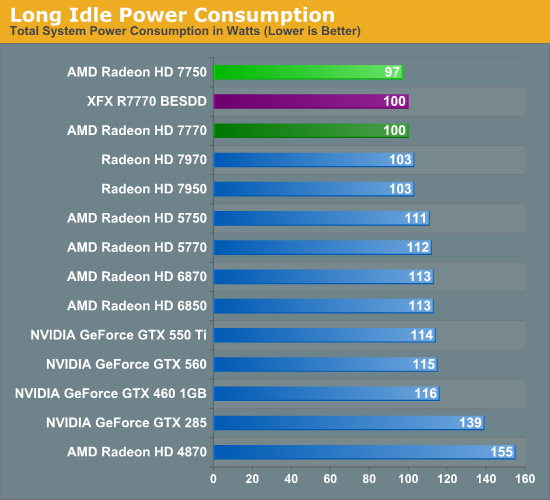
Meanwhile under the so-called “long idle” scenario with a blank monitor, the 7000 series continues to cement its lead. Officially all Southern Islands cards have a long idle power consumption level of <3W since they should all be using the same PCIe controller to keep a heartbeat going, however we’re finding there is a difference, even between the 7750 and 7770. The 7770 consumes 3W less than the 7900 series, meanwhile the 7750W consumes another 3W less, bringing it down to 97W. Since our readings are from the wall it’s tough to gage just how much these cards are still using, but at this point there doesn’t seem to be much farther to drop.
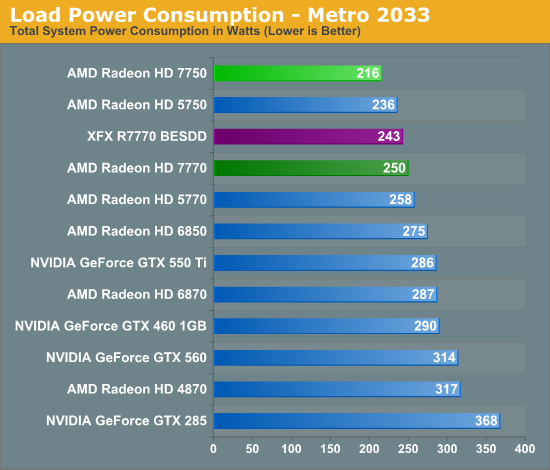
When we talk about the 7700 series bluring the line between what we’d expect out of an AMD 700 series card and an AMD 600 series card, results like this are part of the reason why. With a 75W PowerTune limit the 7750 has the lowest power consumption of any of the cards in our lineup, beating even the 5750. The 7750 is clearly in a league of its own, with only the 7770 drawing similar amounts of power as the 5700 series.
To that extent, it’s interesting to note that the XFX BESDD consumes less power than the reference 7770, in spite of its factory overclock. XFX did not increase the voltage of the card, but we’d still expect power consumption to go up at least a bit, not come down. In any case even with its 10% better performance, it’s consuming 7W less than the reference 7770 here. Otherwise at 250W the 7770 is pulling 8W less than the 5770 and 25W less than the 6850 from the wall, succinctly showcasing the power benefits of TSMC’s 28nm process.
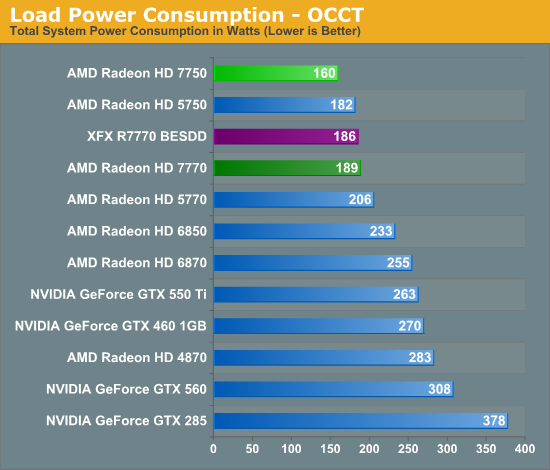
Our results with OCCT largely mirror Metro, with the 7750 in a class of its own while the 7770 consumes less power than anything other than the 5750. Since this is our pathological test, the lack of PowerTune plays a big part here, as PowerTune keeps the 7770 capped at 100W while the 5770 and 6850 are free to go well over their TDPs.
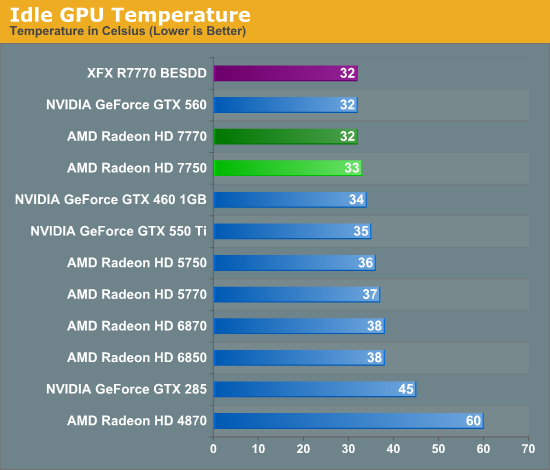
There’s little to say about idle temperatures that hasn’t been said before. With a half-decent cooler, almost any card can reach the mid-to-low 30s. The 7700 series is no exception.
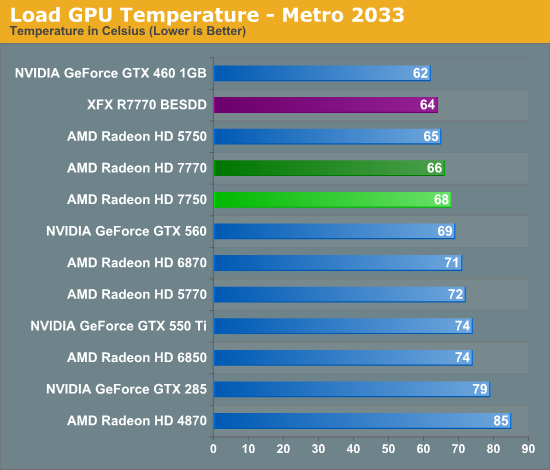
Moving on to Metro, our results are largely consistent with what we’d expect given our earlier power data. Even with the lower power consumption of the 7700 series AMD can’t quite beat the GTX 460 1GB, otherwise with temperatures in the mid to upper 60s the 7700 series looks quite good. XFX’s BESDD looks especially good thanks to the fact that it’s an open air cooler, as it only reaches 64C.

As with OCCT power consumption, OCCT temperatures are largely a story of PowerTune or the lack thereof. With PowerTune clamping down on power consumption, temperatures never rise by too much. At 71C the reference 7770 is still doing well, while XFX’s card does even better.
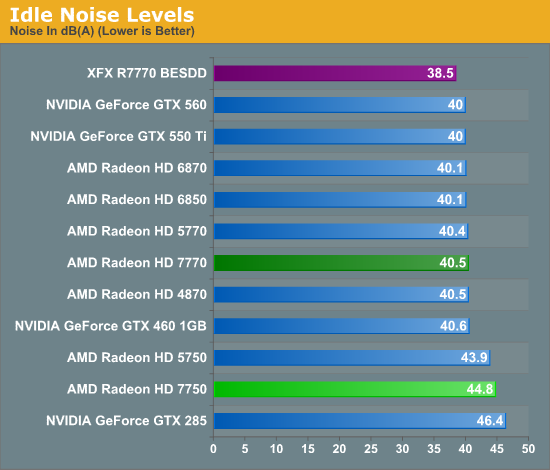
Based on our power and temperature data, our noise data came at somewhat of a disappointment. The 7750 has a small fan with an idle fanspeed of 39%, leading to it being quite loud relative to its competitors. Thankfully none of AMD’s partners will be using that specific cooler, so we wouldn’t expect any retail cards to be this bad. Though if silence is key, Sapphire’s passively cooled 7750 is always an option.
As for our 7770 cards there aren’t any surprises. The open air cooled XFX BESDD does the best, though at only 40.5dB the reference 7770 is doing almost as well on its own.
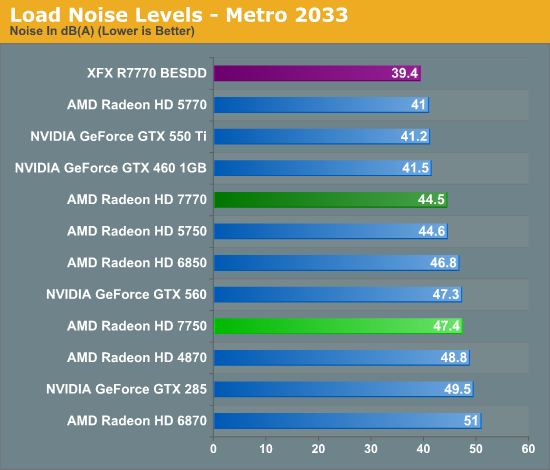
I had to rerun Metro a few times just to make sure our XFX BESDD numbers are right; and they were. XFX’s open air cooler combined with the 100W board limit of the 7770 means that there’s relatively little heat to dissipate, which the open air cooler does extremely well. While this isn’t technically silent it’s damn close.
Elsewhere the reference 7770 does decently, but its half blower nature hurts it when it comes to noise. The noisy 7750 only gets louder, unfortunately.
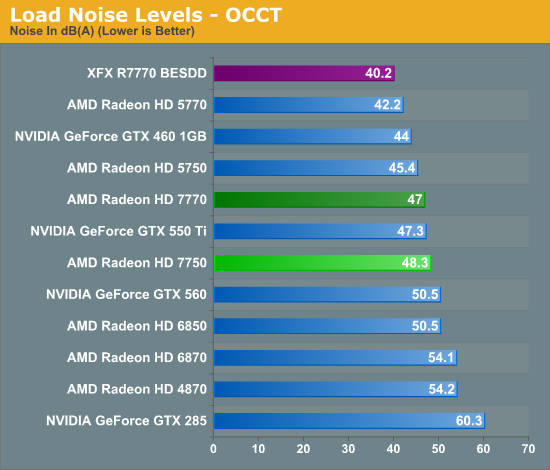
Finally, noise under OCCT is nearly the same story. The XFX BESDD finally goes above 40dB, a testament to the capabilities of XFX’s open air cooler. As for the AMD cards, there’s really not a great deal positive to say as even a traditional blower shouldn’t be quite as bad as what we’re seeing with the reference 7770. Perhaps it’s for the best that none of AMD’s partners are using their reference designs.










155 Comments
View All Comments
Dianoda - Wednesday, February 15, 2012 - link
Yeah, I jumped on that BB/Visiontek HD4850 512MB deal as well. Bought the card about a week before the official launch and at a $50 discount on top of that. Timing was perfect, too, as I had just finished my build, short one video card (borrowed a 3850 from a friend for a few weeks).I finally upgraded from that card to a 6950 2GB (BIOS modded to 6970) about a month ago - Skyrim was just too much for the 4850 to handle @ 2560x1440. The 6950 2GB is a great card for the price if you're willing to perform the BIOS mod (and don't mind rebate forms).
nerrawg - Thursday, February 16, 2012 - link
Exactly! I bought 2 4850's in the UK in 2009 for £65 ($95) each - best GPU purchase I have made in 12 years! I now have a single 6870 that I bought in 2011 for £120- but its not really an upgrade at all. Thought I would wait and get a second one cheaper but now I don't think that will happen2008-2009 was the sweet spot of a decade for Desktop GPUs. The way things are going with the Desktop (AMD bullsnoozer etc. etc.) I fear that it might have even been the sweet spot of GPU performance for the decade to come as well. I would love to see some massive progress in graphics, but it seems that the all the "suites" care about now days is "smart" this and "smart" that. I can't really blame them either, because until pc programmers get their act together and actually start making apps and games that push what is possible on current hardware I don't see any reason why I need 2X the GPU and CPU compute power every 1-2 years.
Come on guys - we are all waiting for the next "Crysis" - if it doesn't come then it might spell the end of the enthusiast desktop
StrangerGuy - Wednesday, February 15, 2012 - link
AMD having a fail product at $160 that couldn't even beat an almost 1.5 year old $150 6870 isn't surprising considering they are also the ones with the cheek to price their FX-8150 at near 2600K prices.thunderising - Wednesday, February 15, 2012 - link
The only problem I have with AMD on this card is WHY THE LOW BANDWIDTH.The card performs nearly 10% faster when the memory is clocked at 6GHz QDR (TPU reviews) and 15% with Core Clock matching XFX's OCed Speed.
I think that 6GHz memory modules would have taken the HD7770 a long way ahead. The performance boost would have been enough to hit HD6850 performance, or beat it in all cases, and at that point, this card at 159$ would make sense.
Right now, until the price hits about 129$, this doesn't make sense.
chizow - Wednesday, February 15, 2012 - link
But you get GCN, 28nm and a bottle of verdetard?Zoomer - Wednesday, February 15, 2012 - link
GCN is worse than useless for gamers and non compute users.jokeyrhyme - Wednesday, February 15, 2012 - link
I think I've built my last system with an AMD CPU. Intel completely abused their monopoly and decimated AMD's success in the CPU department, and I don't think AMD will have an enthusiast-quality CPU ever again. :(That said, I think I will still use AMD GPUs for a while yet.
nVidia's Kepler may beat AMD later this year, but AMD actually has an open-source driver developer on staff and routinely publishes hardware documentation. AMD GPUs will probably have better support for Wayland than their nVidia counterparts due to these factors. If you use Linux and want to stay on the cutting edge, then I don't think picking nVidia is particularly wise.
ganeshts - Wednesday, February 15, 2012 - link
At least in the HTPC area, NVIDIA is miles ahead of AMD in the open source support department.Almost all Linux HTPCs capable of HD playback have NVIDIA GPUs under the hood, thanks to their well supported VDPAU feature.
AMD started getting serious with xvBA only towards the end of last year, and they still have a lot of catching up to do [ http://phoronix.com/forums/showthread.php?65688-XB... ]
Ananke - Wednesday, February 15, 2012 - link
AMD is several years behind NVidia on the compute side...actually they are nowhere as of today. The AMD 7xxx series is so ridiculously priced, it will not get an user base to be attractive for developers. Actually, I am at the point of considering NVidia cards for computing, despite that I hate their heat and power consumption.AMD had their chance and they blew it.
Besides, we shall see where the AMD ex-VP will go - that company most likely will be the next big player in graphics and high performance computing. Probably Apple.
PeskyLittleDoggy - Thursday, February 16, 2012 - link
In my country, company policy dictates you cannot leave your company and work for a competing company if you have valuable R&D knowledge. Thats part of the restraint of trade clause in your contract.Basically what I'm saying is, AMD's ex-VP will not be able to work in any company with a graphics department for 2 years if the contract is similar to mine. I can't remember now but some CEO was sued for that recently.